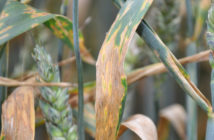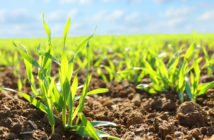The ability to fit a range of drilling slots within a rotation that includes summer-harvested combinable crops, sugar beet lifted in winter and field vegetables cut in early spring is proving to be the key benefit of wheat variety Belepi on a Lincs farm.
Earliness of harvest is another benefit of the variety, believes Stephen Wrisdale, of Spilsby-based Malcolm Wrisdale Ltd. And with significant populations of blackgrass across some of the business’s 880ha, Belepi’s prostrate early growth habit is also being valued as an extra tool to combat the weed.
The business is now in its third year of growing the variety, which is marketed in the UK by Ebbage Seeds. With a rotation that comprises winter and spring wheat, winter oilseed rape, vining peas, sugar beet, cabbage and potatoes, crops are being either sown or harvested across much of the year, and the biggest benefit of Belepi is its ability to fill a variety of roles within that rotation, says Mr Wrisdale.
“For example, if required, we can drill the same variety after Dutch cabbage in November, after sugar beet in January, and after Savoy cabbage in March.
“We’ll have an initial plan for where it will go, but once we have the seed ordered and delivered in the autumn, we know that we’re not at the mercy of the weather or the calendar in terms of where and when it can be drilled, should the plan need to change.”
Over the past three years, Belepi has been drilled on the farm in early October as a first wheat, in late October as a second wheat, and at various dates from February to April after sugar beet or cabbage. While best results have so far come from October drilling, Mr Wrisdale says he is not growing the variety for out-and-out yield.
“Its most impressive performance has actually come from a last bit of ground – around 3.5ha – that we drilled in spring at a very low rate of 35kg/ha because we were running short of seed. It went on to yield 7.5t/ha. Usually we drill at 125kg/ha, adjusting for thousand grain weight, soil type and drilling date.”
But beyond yield and width of drilling window, Belepi’s growth habit and its role in blackgrass control was one of the reasons Mr Wrisdale chose to grow the variety for seed when first approached by Ebbage Seeds.
“We suffer badly from blackgrass on some parts of the farm, and although we have a broad range of cropping, we are also trying to adopt a more ad hoc rotation to manage the problem on a field-by-field basis. We’ve been growing more spring crops for the past four years, and are trying to reduce the area of second wheats we grow. We’re also looking to boost organic matter and improve drainage, to reduce conditions favouring blackgrass, as well as fallowing some land and trialling some catch-cropping. Belepi’s spreading early growth habit is another possible tool to help here.”
The amount of residual nitrogen available from the previous crop in the rotation, particularly cabbage, can help wheat growth early on, notes Mr Wrisdale, but colder nights this spring meant that was less readily available this year.
“That made little difference to the Belepi, though, which is a steady starter anyway. Early on it seems slow to get going and can look uneven, and it seems to sit still for ages. But the spreading nature of its early growth keeps it above the blackgrass and smothers it, before the crop later takes off and evens up by flag leaf.”
Earliness of maturity is another Belepi benefit, he suggests, meaning it helps to spread the harvest workload and provide an early entry for oilseed rape.
“Whether it’s autumn- or spring-drilled, it comes off early enough to provide plenty of time to get rape in the ground, and as a late autumn driller it’s far faster to mature than Grafton. Last year we cut both varieties on the same day, despite the Grafton having been drilled in September and the Belepi a month later.
“Although we haven’t seen any of our second wheats perform particularly well recently, Belepi has outperformed Grafton and Kielder in this slot. While it was just edged on specific weight, at 74kg/hl versus 75kg/hl for Grafton, the Belepi produced 2.5t/ha more yield, at 10t/ha.
“It’s not a variety to produce the biggest yields, but as a management tool it definitely has a place in our rotation.”



